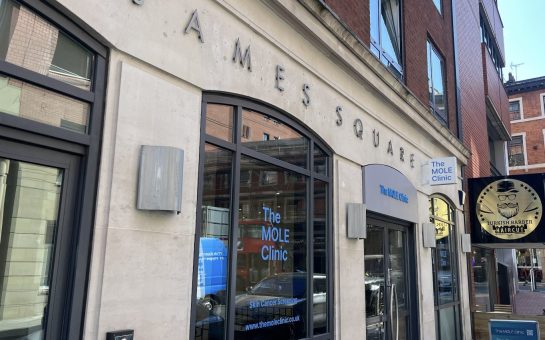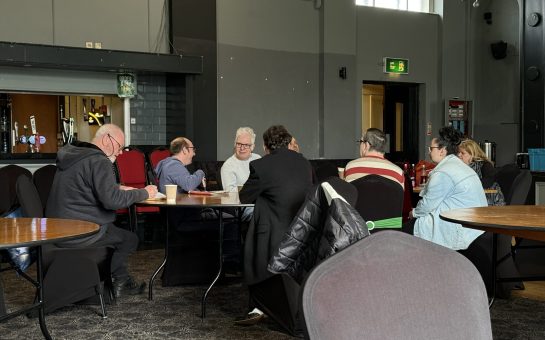Ever wondered what you would do if you had the keys to the city? Could you fathom the places you would go, the sites you would see, the wonders you would behold?
There is a craze sweeping the streets of the world’s most populous cities called ‘Ruin Porn’.
The fad sees photographers and artists go to drastic measures to explore the growing number of decaying buildings that have fallen into a harsh obscurity. In many instances, the steady footsteps of these snappers are the first in decades and, in some cases, the last.
These explorers become ambassadors of sorts and the role of storytellers is bestowed upon them.
Photographers try to communicate an untold message and do so in their own way. It is no easy feat as they are required to negotiate a building’s thriving history against its decrepit present.

ICONIC: BBC Oxford Road
The flash of a lens has the power to swiftly bring a building back to life, or capture its miserable death.
One of Manchester’s most engaging storytellers is Essex-born Andrew Brooks whose work utilises this growing trend but with a twist.
‘Ruin Porn’ is a branch of Urban Exploring. Its increasing popularity is seen all over the globe, with Detroit, Michigan being a key hotspot. Unlike this US city that has been infamously crippled by economic depravity, Brooks is eager to explain that Manchester is treated with added sensitivity.
“People are travelling all over the world to see these places and the locals are getting really pissed off with it because it’s only showing one side of their town,” he told MM.
“There are elements which are frowned upon but I’m hoping that I show it from a different angle.”

CAPTURING THE EXPERIENCE: Hulme Hippodrome
Unlike Detroit, the Mancunian platform is one that stretches hundreds of years further. It has a storied history of arts and craftsmanship that either fell into obscurity or were simply outgrown.
From Albert Hall to the Hulme Hippodrome, Brooks admits that he feels an obligation to accurately convey these places back to the community.
“I set myself the brief to create images that capture the whole experience of being there so I really did a lot of work on the way the light fell and the way the textures felt,” he said.
“With all my work I wanted to feel like you can step into them and almost reach and touch the gravel on the floor.
“I didn’t just want to show people what it looked like really, but the feeling of the place.”
Brooks’ technique differs slightly from other explorers as he asks and waits for permission before embarking into these often private buildings. This can often be a frustrating process as approval can sometimes take months or never be granted.

WHAT LIES BENEATH: Central foundations
Consent is essential for Brooks as it is generally accompanied by an account of the property and its use over time.
This allows him to gain an understanding of the history behind every snap which he feels helps to properly portray the buildings.
“I try to read the buildings,” Brooks told MM.
“Usually there are different ages, different things being added at different times and you look at the walls and the bricks to see what’s been added and get an understanding of how the building has kind of evolved and quite a lot of buildings have signs of that.”
These buildings seemingly long for the energy and the resumed-appreciation that the explorers bring with them. They yearn for restoration, refurbishment and a new-found purpose.
The questions are, can and should they be resurrected?
“These buildings, the ones that just stopped making sense after a bit, they can be brought back to life,” explained Brooks.
“You can’t be too precious about these places and if they are brought back to life that’s the best thing that could happen.”
This is not always possible however. Some are doomed to meet a crashing end as they are demolished into a sea of rubble with a wave of memories being swept away with it.
This was true of the old BBC building on Oxford Road that was finally destroyed in 2013. While its legacy only spun several decades, Brooks felt an added poignancy when he ventured into its structure only months before it vanished from the road side.

RUBBLE: BBC’s final days
“It was strange because it was the first building I’ve been into which was abandoned that I knew when it was up and running,” Andrew said.
“I know a few of the people who worked in there. People who had spent a lot of their lives in there – people who had met their wives in there.
“Although it’s not the prettiest building people still have a connection to it.”
This is the kind of emotional upheaval that a derelict building can cause. While thousands of people walk past these edifices each day with little interest, it is still a unique kind of privilege to bear witness to the fading beauty while it still stands.
Such beauty was evident in one of Brooks’ fondest locations, the Albert Hall. This is not just because of what he saw, but what he heard. The site is home to an idle organ and he listened in awe as the instrument let out its first noise in over 40 years.

FORGOTTEN TREASURE: Albert Hall
“I was honoured that I got to hear that noise. I’ll always feel very lucky that I’ve seen these places in these strange dusty states because they are rather romantic in a way.”

UNPLAYED IN YEARS: Albert Hall’s organ
The aspirations of urban explorers know no limits. There still remains places they can only dream of venturing into, no matter where these may be.
The most alluring spot in Manchester still escapes Brooks: the Guardian Tunnel.
This underground passage spans across the city centre and with its history as a nuclear bunker it is enough to ignite the imagination of any Mancunian.
Brooks said: “I think there is something really juicy and scary about anything that ties in with the cold war, particularly so close to home.
“I’ve been in a few places that represent the paranoia of nuclear warfare but to know there is a tunnel running under the city, that’s something I need to see.”

GOING UNDERGROUND: Canal tunnel
As buildings rise around the city and we become encouraged to think ‘out with the old in the new,’ it never hurts to take a moment to consider what is inside the buildings with the locked doors and the empty rooms.
You can visit Andrew’s website here and follow him on Twitter at @AndrewPBrooks.
Images courtesy of Andrew Brooks, with thanks
For more on this story and many others, follow Mancunian Matters on Twitter and Facebook.



